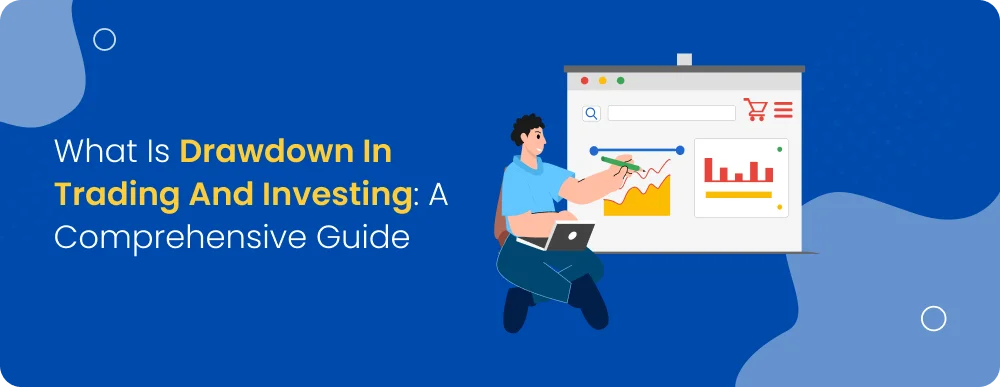What is Drawdown in Trading and Investing: A Comprehensive Guide
Noor Kaur
21 Mar 2025Tags:
Investing
Managing risk is a fundamental aspect of trading and investing, and one of the key risk indicators is drawdown. Understanding drawdown helps you evaluate portfolio performance, manage risk effectively, and develop strategies that protect your capital. This guide covers drawdown, its types, its impact on traders and investors, and how to manage it effectively.
What is Drawdown?
Drawdown refers to the decline in your trading or investment account from its highest value (peak) to its lowest value (trough) within a specific period. It helps you measure risk by showing how much your capital has decreased before recovering.
Drawdowns are normal in trading and investing but need to be managed carefully. A large drawdown can take more time and effort to recover, affecting long-term profitability.
Types of Drawdowns
The most common types of drawdowns are:
Maximum Drawdown
The largest decline from a peak to a trough before a new peak is reached.
Example: If your portfolio grows to $50,000 but then drops to $35,000 before recovering, the max drawdown is 30% (a $15,000 drop from the peak).
A high max drawdown signals higher risk.
Average Drawdown
The average of all drawdowns over a specific period.
Helps you understand the regularity and severity of losses in a portfolio.
If your strategy consistently has deep drawdowns, it may need adjustments.
Calmar Ratio (Risk-Adjusted Return)
Compares the annual return to the maximum drawdown.
A higher ratio indicates better risk management.
Used to evaluate long-term investment strategies.
How Drawdown Impacts Traders and Investors
Some ways that drawdown impacts traders and investors are:
Larger Drawdowns Require Higher Recovery Gains:
A 10% drawdown requires an 11% gain to recover.
A 50% drawdown needs a 100% gain to break even.
This is why traders closely monitor max drawdown in trading to avoid deep losses.
Poor Risk Management Leads to Forced Exits: A large drawdown can cause emotional trading or forced exits. Setting stop-loss levels and adjusting position sizes can help control risk.
Historical Drawdowns Offer Market Insights: Examining the S&P 500's drawdown history helps traders and investors prepare for market downturns. Past data can guide risk management strategies.
How to Calculate Drawdown
The formula to calculate drawdown as a percentage is:
(Highest portfolio value - Lowest portfolio value) ÷ Highest portfolio value × 100
Tracking drawdowns helps refine your drawdown trading strategy and manage risk properly in the stock market.
Suggested Read: Risk Management in Trading: Stop Losses and Position Sizing Explained
Strategies for Managing and Reducing Drawdowns
Drawdowns are unavoidable in trading and investing, but how you manage them determines your long-term success. Effective risk management strategies help minimise losses and improve recovery. Here are key approaches to controlling drawdowns:
Use Stop-Loss Orders to Limit Losses: Setting a stop-loss ensures a trade is closed when losses hit a predefined level, preventing further capital erosion.
Adjust Position Sizing for Better Risk Control: Risking a smaller percentage per trade, such as following the 1-2% rule (risking only 1-2% of capital per trade), reduces the impact of losses.
Diversify to Reduce Risk Exposure: Holding a mix of assets, sectors, or strategies spreads risk, reducing the likelihood of significant drawdowns.
Analyse Historical Drawdowns to Improve Strategy: Studying past S&P 500 drawdown history or market trends helps identify weaknesses in your strategy and make informed adjustments.
Apply Hedging Techniques for Market Protection: Using options, futures, or inverse ETFs can offset potential losses and safeguard your capital during downturns.
Drawdown vs. Volatility: Understanding the Difference
Many traders confuse drawdown and volatility, but they measure different aspects of market risk. Here’s a quick comparison:
Aspect | Drawdown | Volatility |
Definition | Measures the decline from a peak to a trough over a specific period. | Tracks price fluctuations over time, regardless of direction. |
Focus | Evaluates how much capital has decreased and the recovery needed. | Shows the rate and magnitude of price movements. |
Impact | A deep drawdown means significant capital loss that requires time to recover. | High volatility doesn’t always lead to deep drawdowns if the price recovers quickly. |
Risk Indicator | Helps assess portfolio risk and resilience in downturns. | Helps gauge short-term price instability. |
How Different Trading Strategies Are Affected By Drawdowns
Different trading strategies experience drawdowns in unique ways. Some face frequent but small declines, while others suffer deeper losses that take longer to recover from. Here’s how various strategies are impacted:
Trend-Following Strategies: These rely on long-term price movements, so they may experience deep drawdowns during sideways markets.
Mean Reversion Strategies: Trading based on price reversals leads to frequent but smaller drawdowns, with faster recovery.
High-frequency trading (HFT): These strategies limit losses quickly due to rapid trade execution, avoiding deep drawdowns.
Leverage-Based Strategies: Using borrowed money (leverage) amplifies gains and losses, making drawdowns more severe and harder to recover from.
Conclusion
Drawdown is a critical risk measure in trading and investing. While drawdowns are inevitable, managing them effectively ensures capital protection and long-term profitability. You can build a more resilient portfolio by understanding drawdown types, impact, and risk-control strategies.
Explore Our Other Platforms
FAQs
What is a good drawdown?
A "good" drawdown depends on your risk tolerance and trading style. Aggressive traders may tolerate higher drawdowns, while conservative investors aim for lower ones. Generally, keeping drawdowns below 20% is recommended to maintain capital and avoid emotional decision-making.
Can drawdown be avoided in trading?
Drawdowns are unavoidable but can be managed using risk-control measures like stop-loss orders, diversification, and position sizing. The key is to minimise their depth and shorten recovery time.
How does drawdown affect long-term investing?
Large drawdowns can delay portfolio growth by requiring significant gains to recover losses. For example, a 50% drawdown requires a 100% gain to break even, making capital protection essential for long-term success.
How much drawdown is acceptable in trading?
The acceptable drawdown varies by strategy, but most traders aim to keep it under 20% to prevent excessive capital loss. Higher drawdowns can lead to emotional trading and longer recovery periods.
How long does it take to recover from a drawdown?
Recovery time depends on drawdown depth, market conditions, and strategy. A small drawdown (5-10%) may recover in days or weeks, while larger drawdowns (30% or more) can take months or years, especially in volatile markets.
Can drawdown be an indicator of a failing trading strategy?
If a strategy consistently experiences deep drawdowns without recovering, it may indicate poor risk management or flawed execution. Regularly analysing historical drawdowns can help refine strategies and improve long-term performance.
Noor Kaur
21 Mar 2025Related blogs


Intraday Trading Strategy: Open High Open Low Approach
Intraday trading is one of the most exciting and rewarding types of online stock trading. As a day trader, you sho...


Understanding NISM Certification : Everything You Need to Know | mastertrust
In today's world, more and more people are getting curious about finance and the world of money. It doesn't matter...


Seeking Better Returns Than FDs? Explore These Options | mastertrust
Fixed deposits are a popular investment choice because of their guaranteed returns and safety.


Role of Inflation in Long-Term Investment Planning
In Financial Planning, one of the things that plays a key role is the impact of inflation on your investments.
Sign up to our newsletter !
Share this article on
Recent articles
Tags:
Open a Demat Account in just 15 minutes !

Click on open
account below

Fill out some
basic details

Upload your
documents

Start trading in
24 Hours *
Commonly asked questions
Is Master Capital Services Limited SEBI registered?
Do you have a mobile app for Trading and Finance Management?
What services does mastertrust provide?
What is the minimum investment required to start trading with your company?
Is my personal and financial information secure with your company?
What is your customer support availability?





